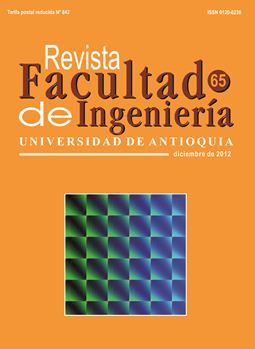Aproximación a la medición del impacto del Backorder en sistemas de manufactura flexible
DOI:
https://doi.org/10.17533/udea.redin.14222Palabras clave:
manufactura flexible, tecnología de grupos, FMS, backorders, planeación y control de la producciónResumen
Este documento estudia las implicaciones que se tienen al considerar o no las órdenes pendientes (que se llamarán de aquí en adelante "backorders") en los modelos de planeación, control y configuración de la producción en sistemas de manufactura flexible (SMF). En muchos de los modelos que intentan estudiar SMF no se considera el backorder, y en aquellos en que es considerado, se incluye como una variable pasiva donde no se ha advertido de manera explícita el impacto que pueda tener en dichos sistemas y en especial su relación con el patrón de demanda. En la presente investigación se identificaron beneficios directos de la inclusión de backorders en la utilización de capacidad, en el balanceo de carga de trabajo entre grupos de Máquinas (células) y en los niveles de inventario. Finalmente se propone usar el concepto económico de elasticidad para la medición de los impactos reales entre el backorder y otros fctores de producción, estrategia novedosa en este tipo de aplicaciones y que puede ser objeto de investigaciones futuras.
Descargas
Citas
C. Liu, Y. Yin, K. Yasuda, J. Lian. “A Heuristic Algorithm For Cell Formation Problems With Consideration Of Multiple Production Factors”. Int. J. Adv. Manuf. Technol. Vol. 46. 2010. pp. 1201-1213. DOI: https://doi.org/10.1007/s00170-009-2170-0
M. Chen, D. Cao. “Coordinating Production Planning In Cellular Manufacturing Environment Using Tabu Search”. Computers & Industrial Engineering [S.I.]. Vol. 46. 2004. pp. 571-588. DOI: https://doi.org/10.1016/j.cie.2004.02.002
J. Balakrishnan, C. Cheng. “Multi-Period Planning And Uncertainty Issues In Cellular Manufacturing: A Review And Future Directions”. European Journal Of Operational Research [S.I.]. Vol. 177. 2007. pp. 281- 309. DOI: https://doi.org/10.1016/j.ejor.2005.08.027
J. Song. “Order-Based Backorders And Their Implications In Multi-Item Inventory Systems”. Management Science [S.I.]. Vol. 48. 2002. pp. 499- 516. DOI: https://doi.org/10.1287/mnsc.48.4.499.207
S. Viswanathan, S. Goyal. “Incorporating Planned Backorders In A Family Production Context With Shelf-Life Considerations”. International Journal Of Production Research. Vol. 38. 2000. pp. 829-836. DOI: https://doi.org/10.1080/002075400189176
X. Wu, C. Chu, Y. Wang, W. Yan. “A Genetic Algorithm For Cellular Manufacturing Design And Layout”. European Journal Of Operational Research [S.I.]. Vol. 181. 2007. pp. 156-167. DOI: https://doi.org/10.1016/j.ejor.2006.05.035
C. Tsai, C. Lee. “Optimization Of Manufacturing Cell Formation With A Multi-Functional Mathematical Programming Model”. The International Journal Of Advanced Manufacturing Technology [S.I.]. Vol. 30. 2006. pp. 309-318. DOI: https://doi.org/10.1007/s00170-005-0056-3
M. Murugan, V. Selladurai. “Optimization And Implementation Of Cellular Manufacturing System In A Pump Industry Using Three Cell Formation Algorithms”. The International Journal Of Advanced Manufacturing Technology [S.I.]. Vol. 35. 2007. pp. 135-149. DOI: https://doi.org/10.1007/s00170-006-0710-4
B. Malakooti, N. Malakooti, Z. Yang. “Integrated Group Technology, Cell Formation, Process Planning, And Production Planning With Application To The Emergency Room”. International Journal of Production Research. Vol. 42. 2004. pp. 1769-1786. DOI: https://doi.org/10.1080/00207540310001652851
R. Rajagopalan, S. Irani. “Comments On: Integrated Group Technology, Cell Formation, Process Planning, And Production Planning With Application To The Emergency Room Malakooti Et Al”. Internartion Journal Of Production Research. Vol. 44. 2006. pp. 2265-2276. DOI: https://doi.org/10.1080/00207540600557355
B. Malakooti, N. Malakooti. “Some Insights Into Malakooti Et al. ‘Integrated Group Technology, Cell Formation And Process Planning’ Approach”. International Journal Of Production Research [S.I.]. Vol. 45. 2007. pp. 1933-1936. DOI: https://doi.org/10.1080/00207540500392416
N. Wei, O. Mejabi. “A Clustering Approach For Minimizing Intercell Trips In Cell Formation”. Journal Of Intelligent Manufacturing [S.I.]. Vol. 19. 2008. pp. 13-20. DOI: https://doi.org/10.1007/s10845-007-0042-8
L. Pattanaik, B. Sharma. “ Implementing Lean Manufacturing With Cellular Layout: A Case Study”. The International Journal Of Advanced Manufacturing Technology [S.I.]. Vol. 42. 2009. pp. 772-779. DOI: https://doi.org/10.1007/s00170-008-1629-8
R. Askin, C. Standridge. Modeling and Analysis of Manufacturing systems. Group technology. John Wiley & Sons editors. 1st ed. New York. 1993. pp. 163-198.
J. Schaller, S. Erengüc, A. Vakharia. “A Methodology For Integrating Cell Formation And Production 111 Planning In Cellular Manufacturing”. Annals Of Operations Research [S.I.]. Vol. 77. 1998. pp. 1-21. DOI: https://doi.org/10.1023/A:1018965025510
F. Defersha, M. Chen. “A Comprehensive Mathematical Model For The Design Of Cellular Manufacturing Systems”.International Journal of Production Economics [S.I.]. Vol. 103. 2006. pp. 767- 783. DOI: https://doi.org/10.1016/j.ijpe.2005.10.008
S. Ah Kioon, A. Bulgak, T. Bektas. “Integrated Cellular Manufacturing Systems Design With Production Planning And Dynamic System Reconfiguration”. European Journal Of Operational Research [S.I.]. Vol. 192. 2009. pp. 414-428. DOI: https://doi.org/10.1016/j.ejor.2007.09.023
C. Micán, J. Ocampo. Propuesta Metodológica Para La Programación De La Producción En Las Pymes Pertenecientes Al Sector Artes Gráficas, Área Publi-Comercial, De La Ciudad De Cali. Tesis De Pregrado Presentada A La Universidad Del Valle. Para optar por el grado de Ingeniero Industrial. 2008.
A. Kusiak. Intelligent Manufacturing Systems. Group technology models and algorithms. 1st ed. Ed. Prentice Hall. New Jersey (USA). 1990. pp. 206-238.
H. Varian. Microeconomic Analysis. Technology. 3rd ed. Ed. W.W. Norton & Company. New York (USA). 1992. pp. 1-21.
Descargas
Publicado
Cómo citar
Número
Sección
Licencia
Derechos de autor 2018 Revista Facultad de Ingeniería

Esta obra está bajo una licencia internacional Creative Commons Atribución-NoComercial-CompartirIgual 4.0.
Los artículos disponibles en la Revista Facultad de Ingeniería, Universidad de Antioquia están bajo la licencia Creative Commons Attribution BY-NC-SA 4.0.
Eres libre de:
Compartir — copiar y redistribuir el material en cualquier medio o formato
Adaptar : remezclar, transformar y construir sobre el material.
Bajo los siguientes términos:
Reconocimiento : debe otorgar el crédito correspondiente , proporcionar un enlace a la licencia e indicar si se realizaron cambios . Puede hacerlo de cualquier manera razonable, pero no de ninguna manera que sugiera que el licenciante lo respalda a usted o su uso.
No comercial : no puede utilizar el material con fines comerciales .
Compartir igual : si remezcla, transforma o construye a partir del material, debe distribuir sus contribuciones bajo la misma licencia que el original.
El material publicado por la revista puede ser distribuido, copiado y exhibido por terceros si se dan los respectivos créditos a la revista, sin ningún costo. No se puede obtener ningún beneficio comercial y las obras derivadas tienen que estar bajo los mismos términos de licencia que el trabajo original.










 Twitter
Twitter